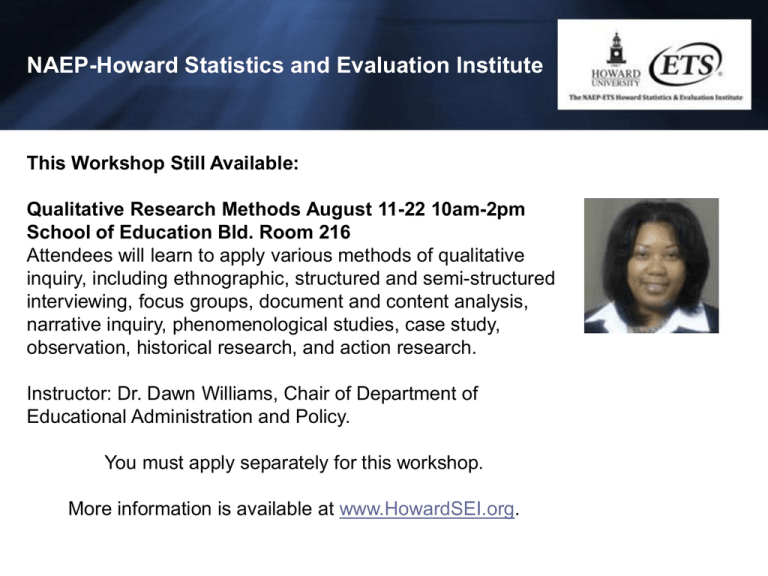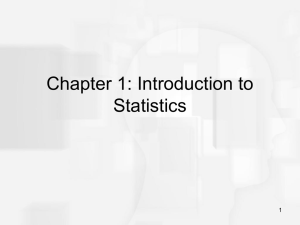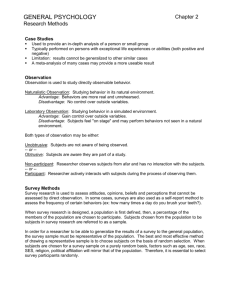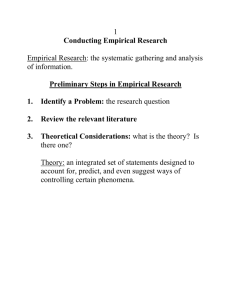Methods
advertisement

NAEP-Howard Statistics NAEP-Howard Statisticsand andEvaluation EvaluationInstitute Institute This Workshop Still Available: Qualitative Research Methods August 11-22 10am-2pm School of Education Bld. Room 216 Attendees will learn to apply various methods of qualitative inquiry, including ethnographic, structured and semi-structured interviewing, focus groups, document and content analysis, narrative inquiry, phenomenological studies, case study, observation, historical research, and action research. Instructor: Dr. Dawn Williams, Chair of Department of Educational Administration and Policy. You must apply separately for this workshop. More information is available at www.HowardSEI.org. NAEP-Howard Statistics Statistics and NAEP-Howard andEvaluation EvaluationInstitute Institute Quantitative Methods for the Social and Behavioral Sciences Dr. Jamie Barden Department of Psychology bardenjamie@yahoo.com Social and Behavioral Sciences :study systematic processes of human behavior. Level of Analysis within individual: neuroscience, brain biology individual: psychology, behavioral genetics social structure: economics, anthropology, sociology, political science, public health “People like it when they understand something that they previously thought they couldn't understand. It's a sense of empowerment.” --Neil DeGrasse Tyson, 2008 “What is the principal of science? The test of all knowledge is experiment. Experiment is the sole judge of scientific 'truth'.” “What business are you in as a scientist? There is an expanding frontier of ignorance...” -- Richard Feynman (1964) Why use the scientific method? To understand relationships between variables in our social world. Empirically test predictions. (birds of a feather/opposites attract) To allow others to independently verify findings. Hypothesis Operationalize Measure Evaluate Revise or Replicate Hypothesis : an explicit, testable prediction about the conditions under which an event will occur. Useful hypotheses should be 1. a priori: before data collection 2. falsifiable: could be found false Hypothesis Where do hypotheses come from? Segue to Inspiration Has your hypothesis been explored already? Segue to Literature Review Operationalize Conceptual variable: The general abstract definition of a variable. (like a dictionary definition) Operational definition: The specific procedures for manipulating or measuring a conceptual variable. (concrete application) Hypothesis (conceptual) similar people will be more attracted to each other Hypothesis (operational) personality test height, age choice of interaction partner attraction questionnaire Construct Validity: How well measures and manipulations reflect the variables they are intended to measure and manipulate. Variables Conceptual (dictionary) Example Feeling scared or a 1. distancing behavior behavioral tendency 2. questionnaire items to distance the self 3. facial expression from a stimuli 4. skin conductance Fear Pick One of Your Variables Operational (concrete measures and manipulations) Methodological Options: Social and Behavioral Sciences Data Collection Approaches 1. Life Record Data 2. Field Study 3. Survey Research 4. Laboratory Research 5. Case Study 6. Focus Group 7. Modeling Types of Study A. Descriptive B. Correlational C. Experimental Which have you used? Measure Three types of studies: 1. Descriptive: What is the level of 1 variable? Ex: What is the president’s overall approval rating? 2. Correlational: How are 2 variables related? Ex: How does survey respondent’s age relate to approval rating? [Predictor is measured] 3. Experimental: Does one variable cause the other? Ex: Does dark vs. light skin in Barack Obama’s photos influence approval rating? [The independent variable is manipulated] Measure: Descriptive Descriptive Research: describes people using the level of a single variable (a thought, feeling or behavior). Types: 1. Observation 2. Historical records (archives) 3. Survey questionnaires Examples? Descriptive Research Example Gallup Daily Poll Measure: Descriptive Random Sampling: Selecting participants to be in a study so that everyone in the population has an equal chance of being in the study. Population Sample Population A random sample (N=1000)Estimate allowsofus to generalize our (mean +/- %) findings back to THIS population. Measure: Descriptive Advantage: easy to do Disadvantage: only involves 1 variable, so no information about relationships between variables. Correlational Research: describes the relationship between two or more naturally occurring variables (predictor and criterion). -Does having a resilient personality relate to mental health outcomes following natural disaster? -Does pre-existing STD infection increase susceptibility to HIV infection? -When the sun is out more, are people happier? Which is the predictor variable? In correlational research the predictor is measured not manipulated. Measure: Correlational Advantage: study naturally occurring variables Disadvantage: correlation is not causation You cannot draw causal conclusions from correlational results. Measure: Experimental Experimental Research: examines cause and effect relationships between variables. Independent Variable (IV) Variable that is the CAUSE of the dependent variable Variable that is manipulated by the experimenter Dependent Variable (DV) Variable that is the EFFECT Variable that is measured NOTE: The IV is manipulated, which helps make it independent of other variables. Measure: Experimental Examples (name the IV & DV): -Are children more likely to be aggressive after being shown violent media content to children (or is there no effect)? -What impact does having a Black person (or not) in an otherwise White group have on decision making? -Is someone more likely to be attracted to you if you emphasize your similarities or differences? -How does alcohol consumption (or not) relate to male decision-making regarding sexual encounters? Measure: Experimental Advantage: cause/effect relationships Disadvantage: can’t manipulate all variables (impossible or ethical reasons). Demos Name that method DEMO Name that method for your research. The End Measure: Experimental random assignment—each participant in the experiment has to have an equal chance of being in any condition, so the conditions start the same. [DEMO] 25 participants needed per condition for a between-participants design. ½ are told about someone similar ½ told about someone different Quasi-experiment Lack of control over the assignment of participants to conditions and/or does not manipulate the causal variable of interest. A quasi-independent variable is not a true independent variable that is manipulated by the researcher but rather is an event that occurred for other reasons. Examples Does smoking cause cancer? Did 9/11 cause an increase in prejudice against people of middle-eastern decent? Do Republican vs. Democratic presidents affect the economy? Do extreme events (i.e., winning the lottery or being paralyzed) affect day-to-day happiness? Does giving employees a raise or extra vacation time boost productivity and job satisfaction? Does campus crime affect applicants to a university? Measure: Experimental Advantage: can investigate quasiindependent variables that are impossible or unethical to manipulate Disadvantage: internal validity threats undermine causal conclusions











